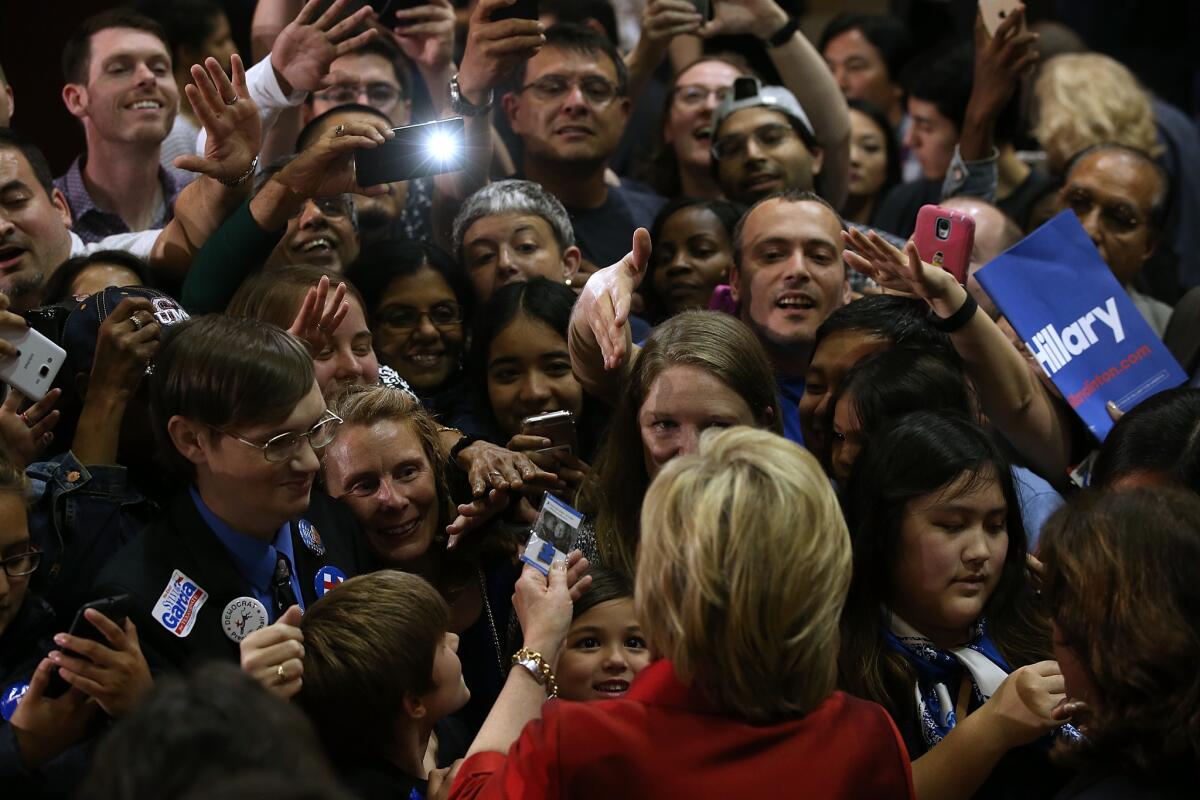Why neither Hillary Clinton nor Bernie Sanders can claim a win in the Latino vote in Nevada

Democratic presidential candidate Hillary Clinton greets supporters during a campaign rally at Texas Southern University on Feb. 20, hours after defeating Sen Bernie Sanders in the Nevada Democratic caucuses.
Reporting from Washington — Hillary Clinton beat Sen. Bernie Sanders in Nevada’s caucuses Saturday, but the two campaigns are still battling for bragging rights on one important point: Who won the Latino vote?
The answer involves conflicting data, which partisans on both sides have cherry-picked to support their case.
The issue matters to both sides because the Clinton campaign has consistently argued that her supporters better represent the ethnic and racial diversity of the Democratic Party. The Sanders campaign says that although the Vermont senator started out with a core of white liberal supporters, he has gained ground among minority voters as more get to know him.
There’s no question that Sanders gained significant ground among Latinos, both in the state and nationwide, in recent weeks. But did he actually win a majority of Latinos in Nevada?
Here’s what we know:
Some 80,000 Democrats turned out to vote Saturday at roughly 1,700 precinct-level caucuses around the state.
Since no one actually counts all those voters by ethnicity or race, there are two ways to estimate voting by Latinos -- or any other group. Both ways involve significant uncertainty.
One set of numbers comes from the poll of voters entering caucus sites, which Edison Research conducted for the Associated Press and the major television networks. Another approach involves looking at results from precincts that have a high percentage of Latino residents to see who won.
The entrance poll showed Sanders winning Latinos, 53%-45%. The Sanders campaign trumpeted that Saturday night in a news release headlined “Sanders wins Latino vote in Nevada.”
Clinton disputes that. “We don’t believe that the so-called entry polls were particularly accurate,” she said in an interview Sunday on CNN’s “State of the Union.”
“Look at the precincts,” she said. “Look at where we dominated.”
Indeed, Clinton did win handily in the areas with the largest share of Latino residents, said Nevada political consultant Andres Ramirez. She won Clark County, which includes Las Vegas, by about 10 points.
“When it comes to the core area of diversity in the state, Sanders got trounced,” said Ramirez, who supports Clinton but does not work for her.
Neither approach -- entrance polls or examining precincts -- yields a definite answer.
The entrance poll has at least two sources of uncertainty. Like any poll, the numbers come with a margin of error. For the full sample, the margin of error was +/- 4 percentage points. But because Latinos made up only about one-fifth of the turnout, the margin of error for them is larger -- 7 points.
In other words, if every Latino voter were counted, the margin of error on the poll indicates Clinton’s share would be between 38% and 52% and Sanders between 46% and 60%.
But there’s another, potentially larger, source of uncertainty: Entrance and exit polls aren’t ideally designed to tell us how different demographic groups voted, particularly those who aren’t spread out evenly across the landscape.
The news organizations that pay for the entrance poll conduct them first and foremost to help quickly project which candidate will win. To do that, they need a sample that reflects the overall vote. In Nevada, that meant sending pollsters to 25 caucus sites around the state to ask a random sample of voters to fill out sample ballots.
That approach works reasonably well for what it’s designed to do -- help project who won. It also works well after the fact for analyzing how large groups voted -- men versus women, for example, or older voters versus younger.
But an entrance or exit poll has much less accuracy for a group like Latinos, who make up a
smaller share of the vote and are concentrated in only certain parts of the state. To accurately measure the Latino vote, a pollster would pick precincts that mirror where Latinos live in order to get a truly representative sample of them. That’s been done in some elections, and the results often differ from the entrance or exit polls designed to sample the overall vote in order to project the winner.
What about analyzing heavily Latino precincts?
A close look at the election returns, such as this analysis by Nate Cohn of the New York Times, shows that Clinton won heavily in neighborhoods with the most Latino residents.
But that doesn’t fully resolve the issue, either, as Cohn noted. Latinos who live in heavily Latino areas might vote differently than Latinos who live elsewhere in the state. Even in heavily Latino precincts, not all voters are Latino. All those issues take on greater weight in a low-turnout election such as a caucus where the voters who actually showed up -- about 7% of the state’s total registered voters -- may differ significantly from the majority of their neighbors.
Given the uncertainties of the entrance poll, there’s a lot of reason to believe the precinct analysis is more reliable and that Clinton probably got more Latino votes than Sanders, but the best answer came from the Vermont senator, himself.
“Who knows?” he said, when asked about the issue on CNN. “Nationally, it is clear that we are doing better and better with Latino voters.”
Staff writer Kate Linthicum in Las Vegas contributed to this report.
For more on Campaign 2016, follow @DavidLauter
ALSO
Democrats move left, Republicans right, and the middle disappears
How Jeb Bush went from favorite to also ran in eight humiliating months
Women and minorities drove Clinton’s victory in Nevada
More to Read
Sign up for Essential California
The most important California stories and recommendations in your inbox every morning.
You may occasionally receive promotional content from the Los Angeles Times.











